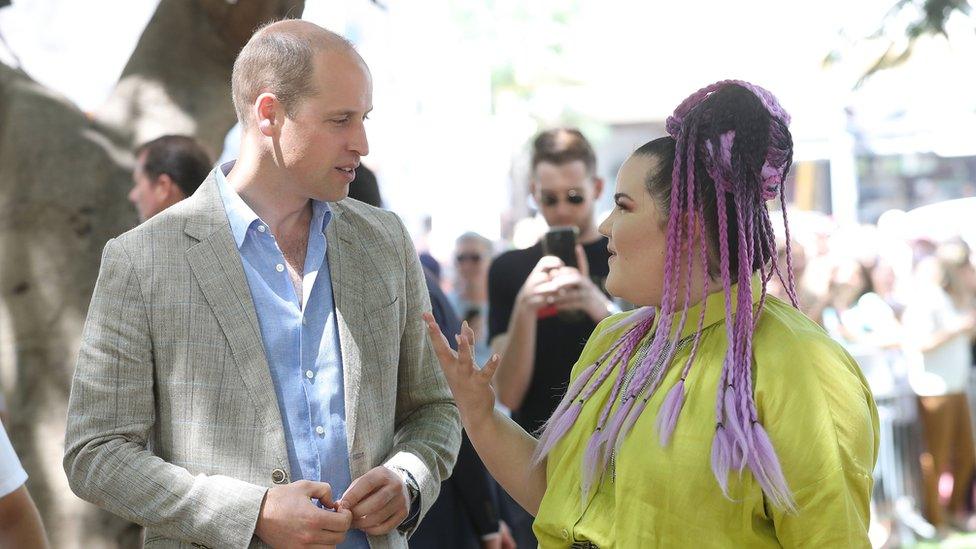Duke of Cambridge visits Jerusalem's sacred sites
- Published
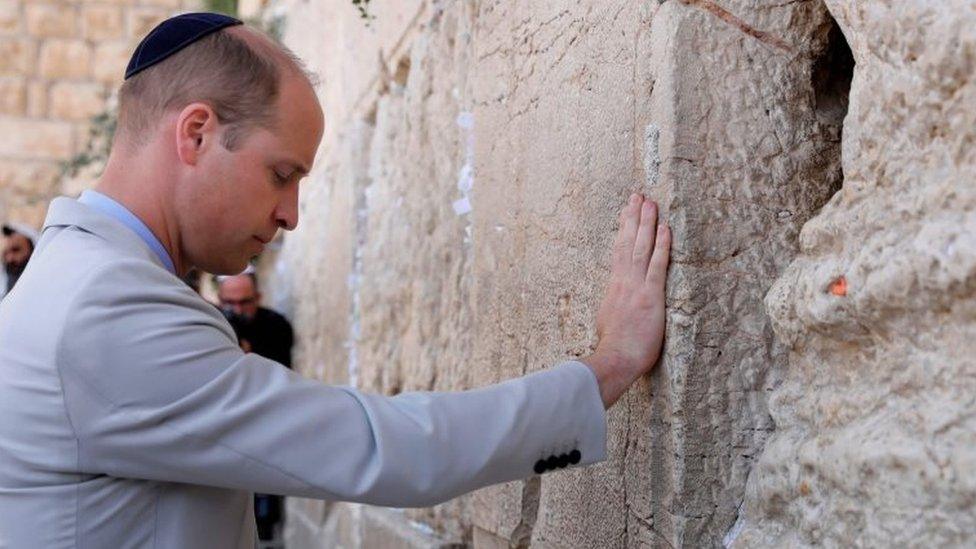
The Western Wall is the holiest site where Jews are permitted to pray
The Duke of Cambridge has visited Jerusalem's most sacred religious sites and his great-grandmother's grave on the final day of his official tour.
He laid flowers at the tomb of Princess Alice - the Duke of Edinburgh's mother - at the Church of Mary Magdalene.
Also on his itinerary was the Temple Mount/Haram al-Sharif, a site that is sacred to Jews and Muslims.
He then went to the adjacent Western Wall, the holiest site where Jews are permitted to pray.
Prince William's tour ended at the Church of the Holy Sepulchre, which is widely regarded as Christianity's holiest place. Many Christians believe Jesus was crucified, buried and resurrected on the site.
It is shared by the Greek Orthodox, Roman Catholic, Armenian Orthodox, Syriac Orthodox, Egyptian Copt and Ethiopian Orthodox denominations of Christianity.
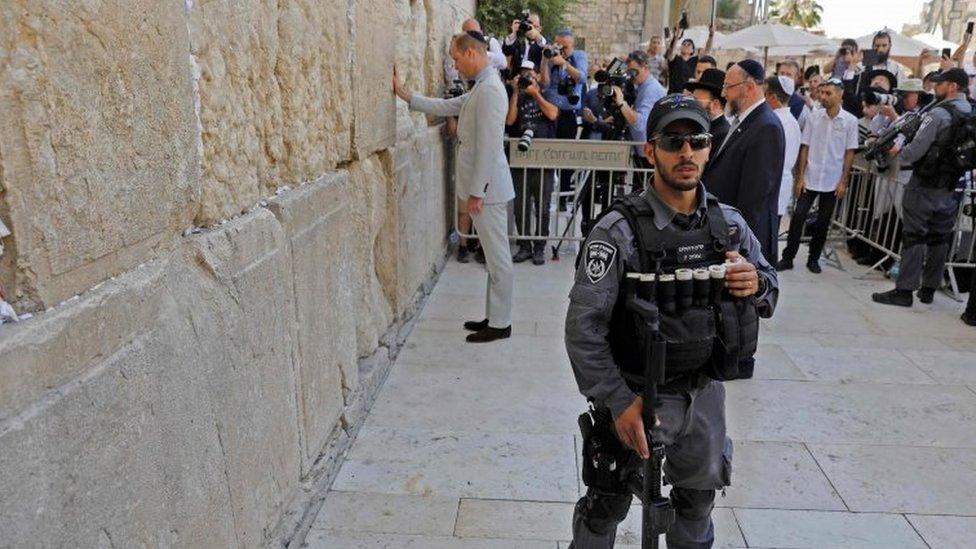
It is the final day of the duke's Middle East tour
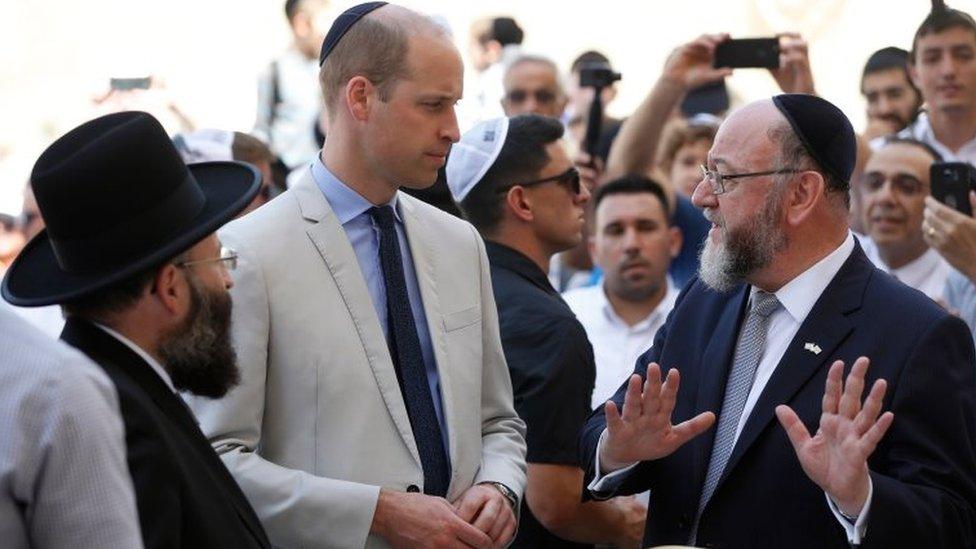
Prince William spoke with Western Wall chief Rabbi Shmuel Rabinovitch and British chief Rabbi Ephraim Mirvis during his visit
The duke began his morning on the Mount of Olives, taking in a view of Jerusalem's Old City.
There, he visited the Church of Mary Magdalene, a Russian Orthodox church and Princess Alice's final resting place.
In keeping with Russian Orthodox tradition, Prince William took bread and salt at the entrance of the church.
Inside, he laid flowers picked from the garden of Philip Hall - Britain's Consul General in Jerusalem - in the princess's crypt.
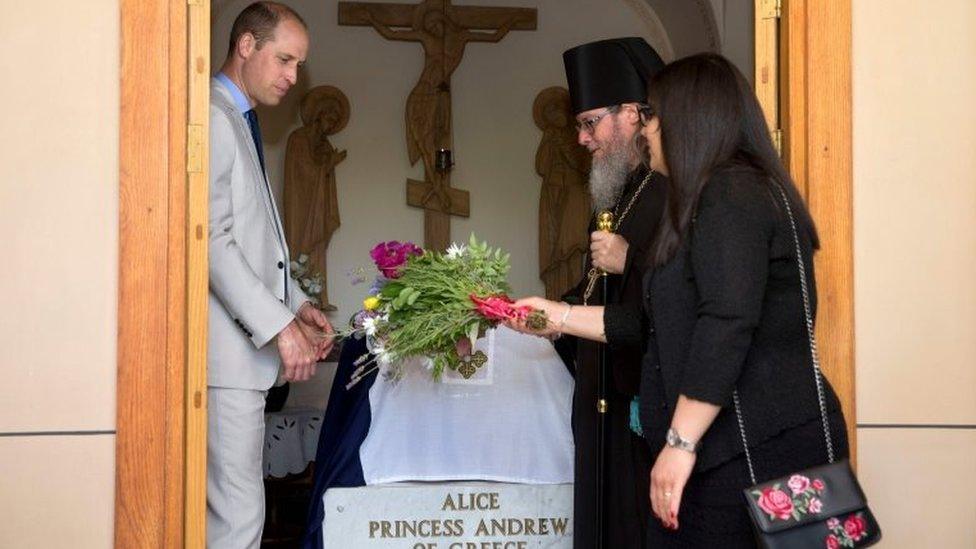
The duke laid flowers at the tomb of his great-grandmother, Princess Alice
Archimandrite Roman, head of the Russian Ecclesiastical Mission in Jerusalem, recited a "prayer for the repose of Princess Alice's soul" and the duke bowed his head with his eyes closed.
After the visit, Father Roman said: "He said he found it profoundly moving.
"He was certainly moved to learn more about his family history and pay his respects to his great-grandmother in such a holy place."
He said he shared a "little joke" with the prince.
"When I was showing him the family tree with the Russian links, I told the prince that I'd read somewhere that someone once asked Prince Philip if he had ever been to Russia, and that he had said: 'They murdered half my bloody family, so maybe I'll go, maybe not'.
"The prince laughed and said: 'He would say that'."

The duke visited the Dome of the Rock and Al-Aqsa mosque at the Temple Mount/Haram al-Sharif
The duke went on to tour the Dome of the Rock and Al-Aqsa mosque at the Temple Mount/Haram al-Sharif.
He was shown around the area by Dr Mustafa Abu Sway, a professor of philosophy and Islamic studies at the city's Al-Quds University, and they spoke about the historical significance of the site.
Temple Mount/Haram al-Sharif sits on an elevated plaza, which was the site of both of Judaism's ancient temples, above the Western Wall in Jerusalem.
Muslims believe it was the site of the Prophet Muhammad's ascent to heaven in the 7th Century.
In Judaism it is where Abraham was instructed by God to sacrifice his son as a test of faith.
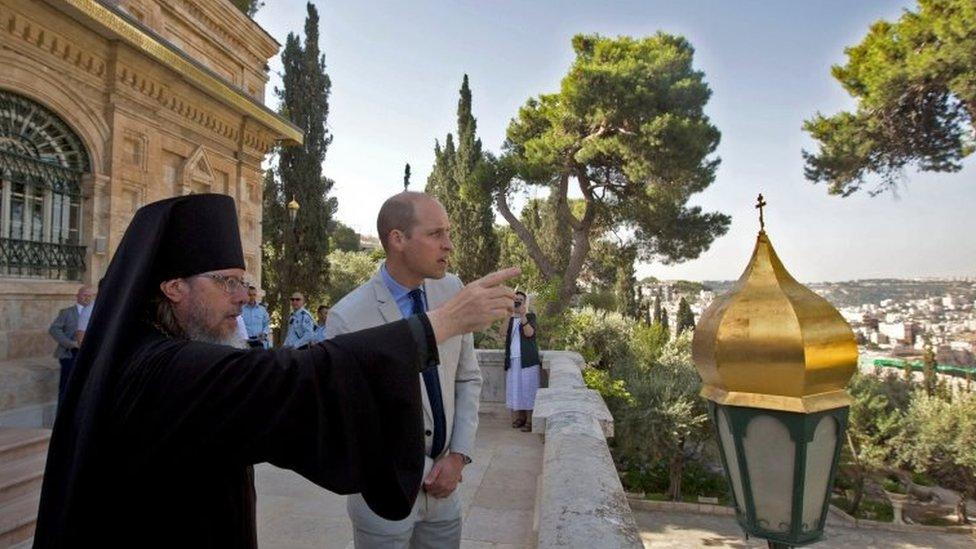
Prince William began his morning on the Mount of Olives, taking in a view of Jerusalem's Old City
During his visit to the Western Wall, Prince William - who was wearing a kippah, or religious head-covering, as a mark of respect - approached the landmark and placed a written prayer in a crack in the ancient wall, as is tradition.
British Chief Rabbi Ephraim Mirvis, who accompanied the prince, said: "Today we experienced a moment of history which will live long in the memory of Jews around the world.
"The Western Wall stands at the epicentre of our faith. To see the future monarch come to pay his respects was a remarkable gesture of friendship and a sign of the duke's regard for the sanctity of Jerusalem."
The Western Wall is a remnant of the retaining wall which surrounded the second Jewish temple at the time of King Herod.

Much to mull over
By Jonny Dymond, royal correspondent, in Jerusalem
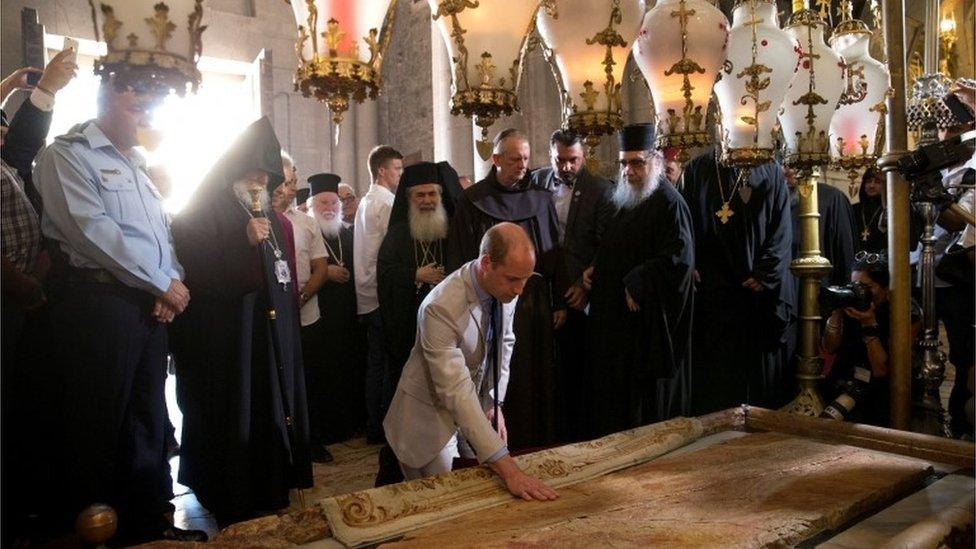
Prince William visited the Church of the Holy Sepulchre in Jerusalem's Old City
After four days of criss-crossing Jordan, Israel and the Palestinian territories, there was time for a little sightseeing. But on an official visit, every step is weighed up against what has come before and what will follow.
The three sites Prince William visited each inspire devotion from the three great Abrahamic faiths - Islam, Judaism and Christianity.
Temple Mount/Haram al-Sharif has been a flashpoint for protests and conflagration. Today the compound was an oasis of calm and beauty in amidst the bustle of the Old City of Jerusalem.
The Western Wall, a remnant from the time of the Second Temple of the Jews was busier. But there is an intensity to the moment you reach the Wall, and close your eyes, and touch the stone, that brings a peace of its own.
And inside the Church of the Holy Sepulchre the Prince got a taste of some of the swirling chaos that the disputatious church lives and thrives upon.
In the space of just a few hours, like so many millions before him, the prince saw and must have felt the religious pull of Jerusalem, the reason that for so many centuries it has been coveted and fought over.
Much to mull over on the flight back to Britain.

The Duke of Cambridge's five-day visit to Israel, the Palestinian territories and Jordan began on Sunday.
Since arriving on his current leg of the tour, he has met Israel's Prime Minister Benjamin Netanyahu and its President Reuven Rivlin, and Palestinian President Mahmoud Abbas.
Princess Alice was married to Prince Andrew of Greece and is remembered for saving the life of a Jewish family in Athens during the Holocaust by sheltering them in her home from the Nazis.
The Duke of Cambridge's great-grandmother, Princess Alice, helped to save Jews during World War Two
On Tuesday, the duke met relatives of the late Rachel Cohen, who was hidden from the Gestapo by his great-grandmother.
Princess Alice, who was a nun for many years, was first laid to rest at St George's Chapel, Windsor Castle, when she died in 1969.
But it was at her request that she was interred, in 1988, at the Russian Orthodox church on the Mount of Olives, near her aunt Elizabeth, the Grand Duchess of Russia.
On Wednesday, Prince William became the first royal family member to make an official visit to the Palestinian territories in the occupied West Bank.
While there he expressed hope for "lasting peace" between Israelis and Palestinians.
- Published27 June 2018
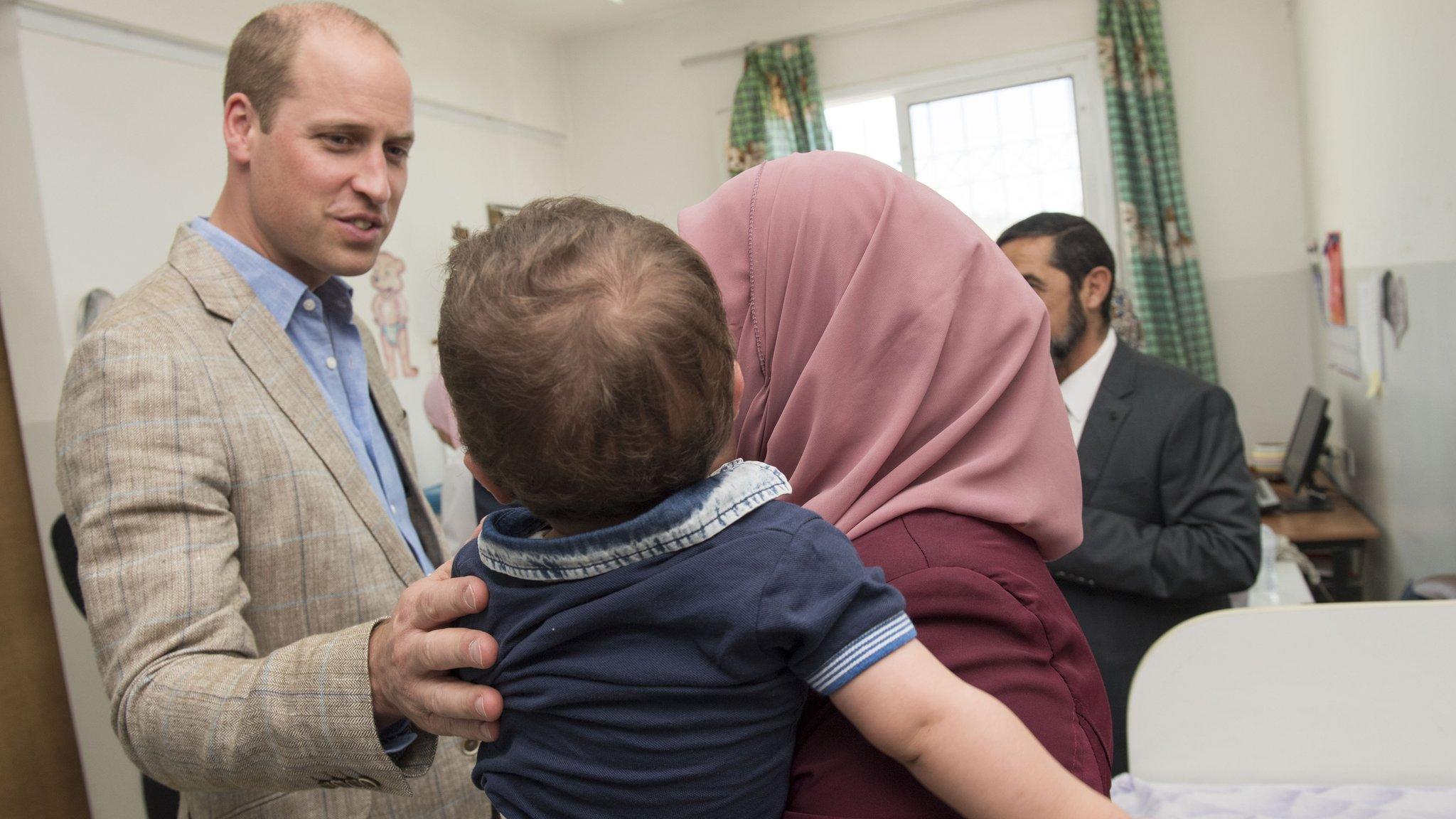
- Published27 June 2018
